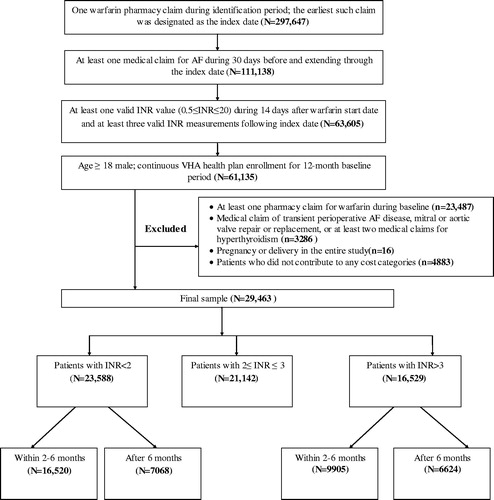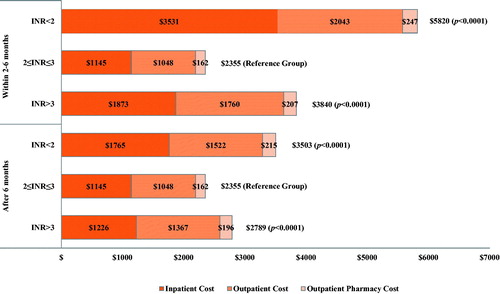Figures & data
Figure 1. Patient selection. AF, atrial fibrillation; INR, international normalized ratio; VHA, Veterans Health Administration.

Table 1. Baseline demographic and clinical characteristics for warfarin patients with NVAF (patients contribute to three cost groups).
Figure 2. Follow-up healthcare costs associated with out-of-range INR, within a 30-day period. Costs and utilization within a 30-day period were assessed starting from Month 2 (31 days post index date) through the end of the study period. In-range INR (2–3): randomly selected INR test occurrence (INR 2–3 result occurred at least 30 days apart and no other INR range type [<2 or >3] occurred within 30 days). Out-of-range INR (<2 or >3): randomly selected INR test occurrence (INR tests occurred at least 30 days apart; different range types occurring within 30 days were allowed). INR, international normalized ratio. *p-Values are based on multiple regression using a generalized linear model.
![Figure 2. Follow-up healthcare costs associated with out-of-range INR, within a 30-day period. Costs and utilization within a 30-day period were assessed starting from Month 2 (31 days post index date) through the end of the study period. In-range INR (2–3): randomly selected INR test occurrence (INR 2–3 result occurred at least 30 days apart and no other INR range type [<2 or >3] occurred within 30 days). Out-of-range INR (<2 or >3): randomly selected INR test occurrence (INR tests occurred at least 30 days apart; different range types occurring within 30 days were allowed). INR, international normalized ratio. *p-Values are based on multiple regression using a generalized linear model.](/cms/asset/ec0db9d7-b0a4-4905-9ca3-8396f425af60/ijme_a_1001851_f0002_c.jpg)
Figure 3. Follow-up healthcare resource use within a 30-day period, for the first 2–6 months and after 6 months of warfarin exposure. Patients with INR 2–3: randomly selected INR test for the 30-day period were collected from the second month through the end of warfarin exposure. Patients with INR <2 or >3: randomly selected INR test occurrence during the first 2–6 months and after 6 months of warfarin treatment. INR, international normalized ratio. *p-Values are based on multiple regression using a generalized linear model.

